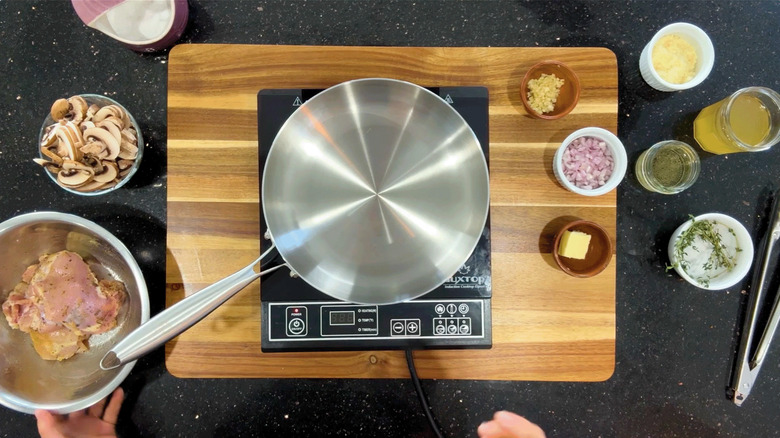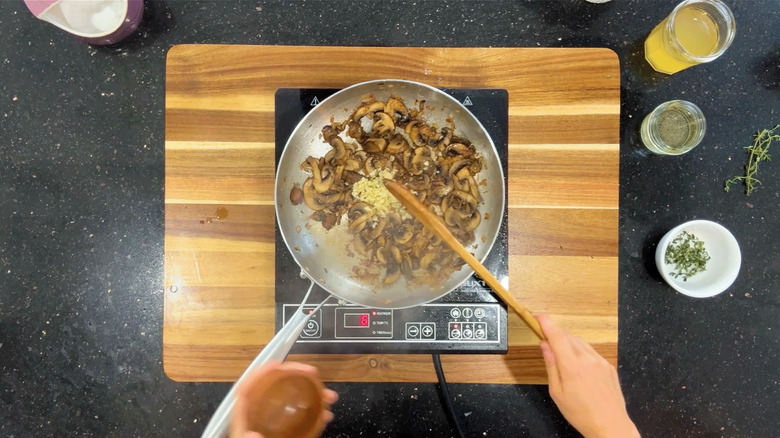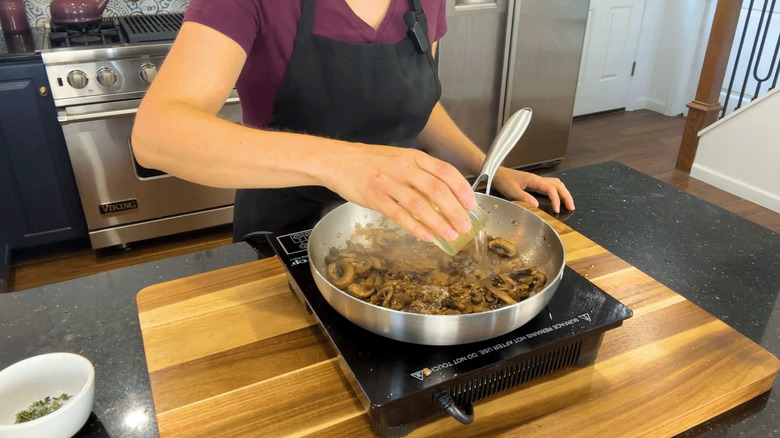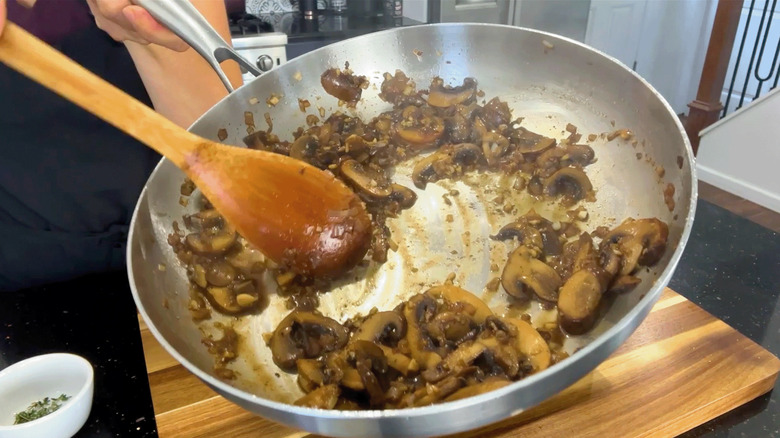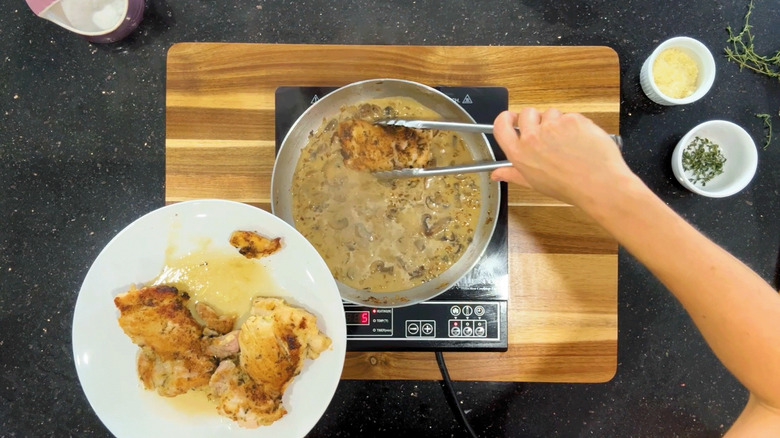How To Deglaze A Pan - You're Doing It All Wrong
If you've ever cooked meat or vegetables in a pan, you might have noticed that when the food interacts with oil, some smaller, charred-looking bits tend to disconnect from the food and end up at the bottom of the pan. It's commonly referred to as fond, and it happens with anything from chicken and steak to caramelized onions. Although you might think those bits are a waste, they're actually loaded with flavor and deserve to be saved. That's where the deglazing process comes in, and Chowhound recipe developer Katie Rosenhouse has all the tips and tricks to properly deglaze.
You need to loosen up those food particles so they can unstick from the pan and be incorporated into the dish. By pouring liquid into the pan, you help remove the particles from the bottom; this is called deglazing. However, as with many elements of cooking, there is a technique to follow to ensure the pan is properly deglazed — and many home cooks miss the mark. Avoid these common mistakes to deglaze your pan just right.
Deglazing works best with stainless steel pans
Those loose food particles are the result of the Maillard reaction, which is a chemical process between proteins and sugars that occurs when food is heated; it's responsible for developing golden color and rich flavors. When it comes to deglazing those food particles, Rosenhouse says it all starts with the right pan. Stainless steel is best, and she warns not to use a nonstick pan. "It's just not going to let those bits really adhere properly, and you're not going to get as complex a flavor when you finish cooking," Rosenhouse says of nonstick. She also recommends using a pan with high sides, so you have ample room to work on the sauce without it spilling over.
Some people prefer nonstick pans for ease, but Rosenhouse offers up an easy way to make sure your stainless steel becomes nonstick. "As long as you get your pan nice and hot before you add your protein in, you should have no issue with it sticking at all," she says. When the meat is ready to flip, you'll know, because it will release from the pan. Add some oil to the pan, and turn the heat on medium-high; when the oil is shimmering, it's hot enough to start cooking.
Enhance the sauce with aromatics before deglazing
Rosenhouse says to add the chicken to the hot oil, then let it cook between four and five minutes before flipping it. Once flipped, let it finish cooking through to at least 160 degrees Fahrenheit so the carryover heat will keep cooking the chicken. But once you remove the chicken from the pan and set it aside, the deglazing fun starts.
Don't skip out on adding some extra personality to the sauce. Rosenhouse suggests enhancing the sauce with aromatics, which should be added after the chicken is removed but before any liquid goes in, while the fond is still in place. Add-ons like shallots, garlic, and mushrooms will build good flavor. Turn the heat to medium, and start by adding some butter for some extra richness. "The amount of butter is up to you, but I feel like butter is just always a good idea."
From there, add the shallots, and let them cook in the butter for about a minute before adding other veggies, such as mushrooms. The liquid from the mushrooms will release and slow the cooking process, which will prevent the fond from burning. "It might even help me scrape some of those [bits] up," she says. Once the mushrooms have cooked for about five minutes, season them with salt and pepper. If you're adding garlic, do so just before you add liquid, and let it cook for no more than a minute.
The type of liquid used for deglazing can vary
Once your veggies and aromatics are cooking, it's time to start adding the liquid. "When you're deglazing, the type of liquid can totally vary," Rosenhouse says. The flavors you prefer, plus the flavors already within the dish, can determine the best liquid to use. She suggests white wine, red wine, broth, or even water — though she doesn't recommend water because it's "flavorless."
"The beauty of wine is that it's got a touch of acidity that's just going to balance and brighten the dish and give us a little bit of extra complexity and depth," she says. You can also use a combination of wine and something else to build those flavors even more. Rosenhouse prefers to add a little wine first, then some broth to bring the sauce together. "Wine is going to do a good job of making the most flavorful sauce."
Deglaze the pan with liquid and a wooden spoon
Rosenhouse suggests adding wine to the pan with the heat still on, and she stresses using a wooden spoon to help remove those bits from the pan's bottom because it's a good scraping tool. Don't forget to act fast. Add the wine, then immediately take the wooden spoon and scrape the bits from the bottom. "You don't want to just let this sit," she adds. "You really want to get in there with your spoon and scrape up all of those bits." Doing this ensures that the concentrated flavor from the fond is well-incorporated into the rest of the sauce.
Once that wine has reduced down, it's time to add the broth, but you need to let that reduce for a little while. "If you don't reduce your liquid, you're just missing out on flavor," Rosenhouse says. Reducing concentrates the flavor better and helps the sauce thicken. Rosenhouse also suggests adding "a touch of cream" to the sauce once it's reduced, for extra richness.
Bring the deglazed sauce together by adding meat or other flavorings
If the deglazing process started from chicken, then Rosenhouse says to add the chicken back into the pan with the new sauce. This not only helps finish the cooking process for the chicken but also adds even more flavor. Rosenhouse notes that once the chicken goes back in, so do all its flavorful juices. Let the sauce continue to heat until it reaches your desired thickness, gently shaking the pan as needed to see how thick the sauce has become.
After the sauce is reduced, you can add some final flavor elements. Rosenhouse says to get however creative you want, even suggesting adding a little bit of tangy Dijon to finish off the sauce. She offers up parsley, fresh thyme leaves, and Parmesan as some great last-minute additions.
When you give your fond a second look instead of tossing it out, you're giving yourself a whole new set of culinary options. Be sure the fond doesn't burn, add plenty of aromatics, and give the sauce enough time to thicken – and you'll find yourself with a fantastic dinner. "A delicious pan sauce, a delicious weeknight meal, all in a matter of minutes."
